 |

Database
Management System
(CS403)
VU
Lecture No.
11
Reading
Material
"Database
Systems Principles, Design and
Implementation"
written
by Catherine Ricardo, Maxwell
Macmillan.
Overview of
Lecture
o Inheritance
o Super
type
o Subtypes
o Constraints
o Completeness
o Disjointness
o Subtype
Discrimination
According
to the Microsoft Dictionary of
Computing
Inheritance
Is
The
transfer of the characteristics of a
class in object-oriented programming to
other
classes
derived from it. For
example, if "vegetable" is a class, the
classes "legume" and
"root"
can be derived from it, and
each will inherit the properties of
the "vegetable" class:
name,
growing season, and so on2.
Transfer of certain properties such as
open files, from
a parent
program or process to another
program or process that the
parent causes to run.
Inheritance
in the paradigm of database systems we
mean the transfer of properties of
one
entity to
some derived entities, which
have been derived from
the same entities.
100
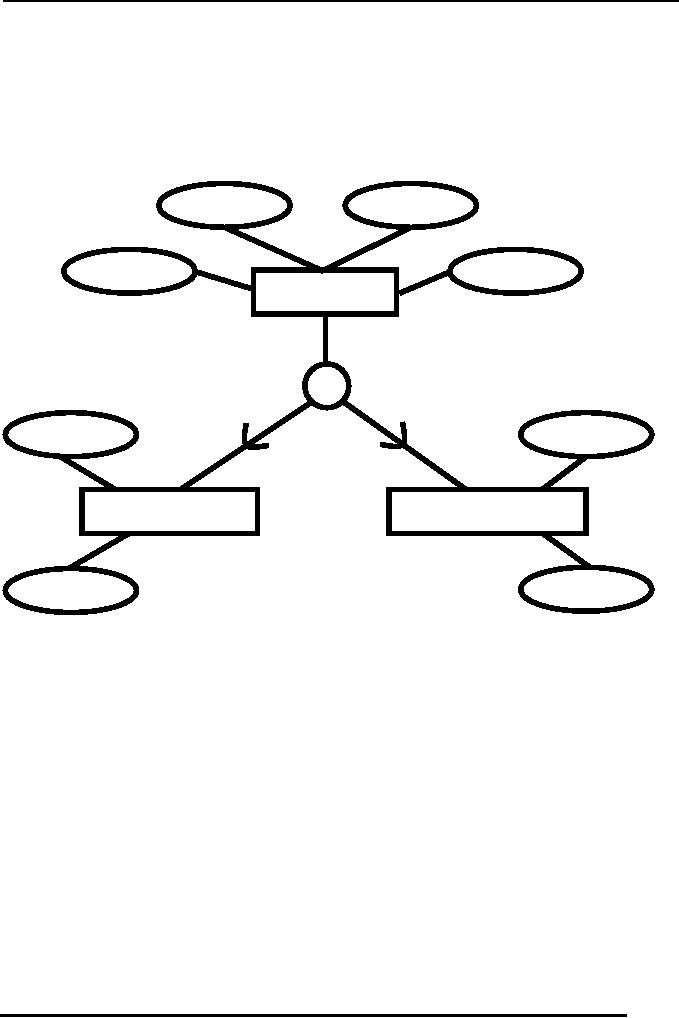
Database
Management System
(CS403)
VU
Super
types and Subtypes
Subtypes
hold all the properties of
their corresponding super-types.
Means all those
subtypes
which are connected to a
specific supertype will have
all the properties of
their
supertype.
EmpName
EmpAddress
EmpId
EmpPhNo
EMPLOYEE
NoOfHrs
Grade
SALARIED
HOURLY
AnnualSal
HourlyRate
Fig-1
a
The
Figure:1 above shows that
the supertype and subtype
relation between the
SALARIED
and HOURLY employees with the
supertype entity EMPLOYEE, we
can
see
that the attributes which
are specific to the subtype
entities are not shown
with the
supertype
entity. Only those attributes are
shown on the supertype
entity which are to
be
inherited
to the subtypes and are
common to all the subtype
entities associated with
this
supertype.
The
example shows that there is
a major entity or entity
supertype name EMPLOYEE
and has a
number of attributes. Now
that in a certain organization
there can be a number
of
employees being paid on different
payment criteria.
101
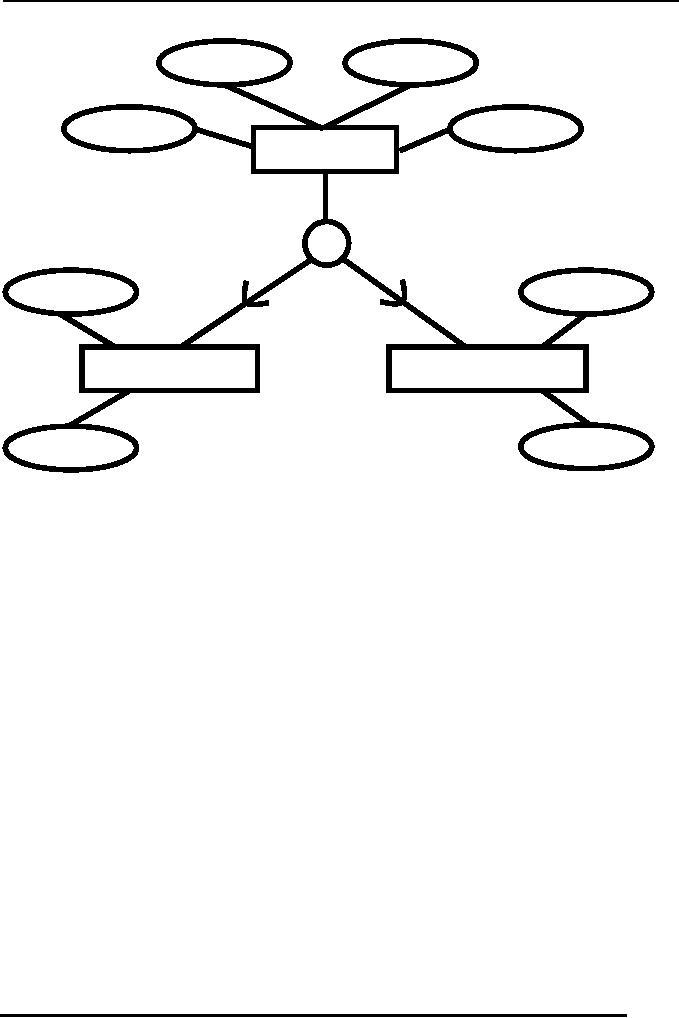
Database
Management System
(CS403)
VU
P_Name
P_Address
P_Id
P_PhNo
PERSON
Qual
C_Name
STD
FAC
CGPA
Grade
Fig
1 b
The
second example is that of
student and the Faculty members
who are at the super
level
same
type of entities. Both the
entities at the super level
belong to the same entity of
type
Person.
The distinct attributes of
the student and faculty members
are added later to he
sub
entities student and
fac.
Supertype
/ subtype Relationship:
The
use of supertype and subtype
for the entities is very
useful because it allows us
to
create
hierarchy of the entities
according to the attributes
they have and we need not
to
write
all the attributes again and again. We
can group similar types of
entities and the
attributes
associated with those entities at
certain levels.
This also
adds clarity to the
definitions of the entities as it is
not necessary to write
the
attribute
again and again for all the
entities.
Moreover
it also eases the operation of
removing or adding attributes
from the entities,
here it is
worth noting that adding an
attribute at the super entity
level will add the
102

Database
Management System
(CS403)
VU
attribute
to the below listed or
derived sub entities and removing
the attribute will
remove
the
attribute from the entities
at sublevels in the same
way.
The
process of identifying supertype and
creating different type of sub
entities is
supported
by the general knowledge of
the designer about the
organization and also based
of the
attributes of the entities
which are entities existing
in the system..
Specifying
Constraints
Once
there has been established a
super/sub entity relationship
there are a number of
constraints
which can be specified for this
relationship for specifying
further restrictions
on the
relationship.
Completeness
Constraint
There
are two types of completeness
constraints, partial completeness
constraints and
total
completeness constraints.
Total
Completeness:
Total
Completeness constraint exist only if we
have a super type and some
subtypes
associated
with that supertype, and the
following situation exists
between the super
type
and
subtype.
All the
instances of the supertype entity
must be present in at one of the subtype
entities,
i.e.--there
should be not instance of
the supertype entity which
does not belong to any
of
the
subtype entity.
This is a
specific situation when the
supertype entities are very
carefully analyzed
for
their
associated subtype entities and no sub
type entity is ignored when
deriving sub
entities
from the supertype
entity.
Partial
Completeness Constraint:
This
type of completeness constraint exists
when it is not necessary for
any supertype
entity to
have its entire instance
set to be associated with
any of the subtype
entity.
103

Database
Management System
(CS403)
VU
This
type of situation exists
when we do not identify all
subtype entities associated
with a
supertype
entity, or ignore any
subtype entity due to less
importance of least usage in a
specific
scenario.
Disjointness
Constraint
This
rule or constraint defines
the existence of a supertype
entity in a subtype
entity.
There
exist type types of disjoint
rules.
o Disjointness
rule
o Overlap
rule
Disjoint
constraint:
This
constraint restricts the
existence of one instance of any
supertype entity to
exactly
one
instance of any of the
subtype entities.
Considering
the example given in Fig 1a
it is seen that there can be
two types of
employees,
one which are fixed salary
employees and the others are
hourly paid
employees.
Now the disjoint rule
tells that at a certain type
an employee will be either
hourly
paid employee or salaried employee, he can
not be placed in both the
categories in
parallel.
Overlap
Rule:
This
rule is in contrast with the
disjoint rule, and tells
that for one instance of
any
supertype
entity there can be multiple instances
existences of the of the instance
for more
then one
subtype entities. Again
taking the same example of
the employee in an
organization
we can say that one employee
who is working in an organization can
be
allowed
to work for the company at
hourly rates also once he has
completed his duty as
a
salaried
employee. In such a situation
the employee instance record
for this employee
will be stored in
both the sub entity
types.
104
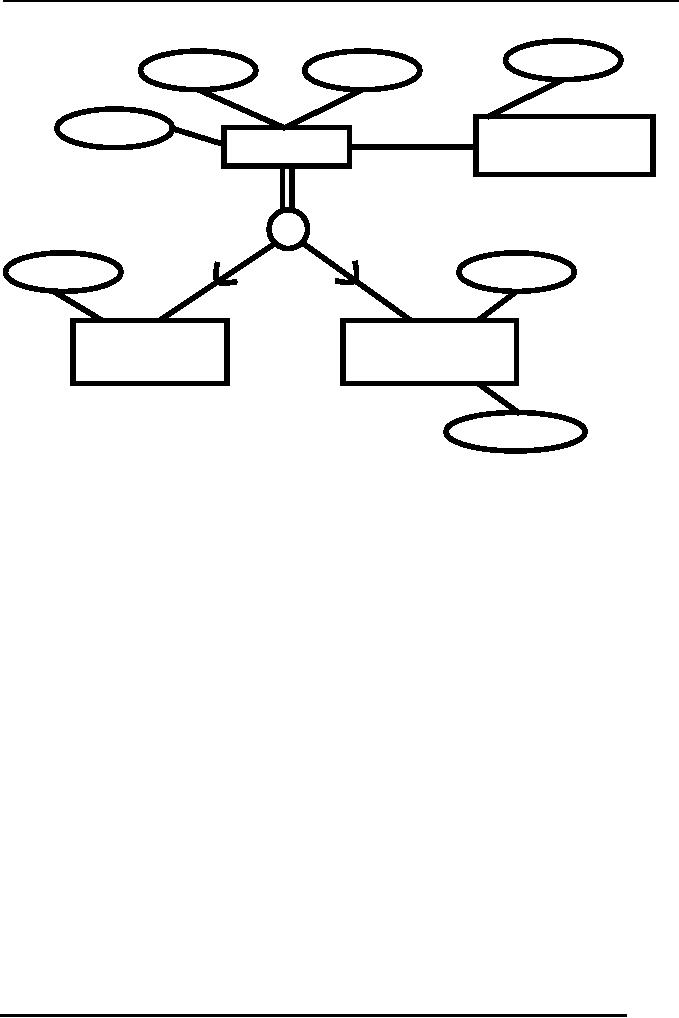
Database
Management System
(CS403)
VU
Ph_Id
P_Name
AdmDate
P_Id
RESPONSIBLE
PATIENT
PHYSICIAN
WardNo
Prescription
OUT
DOOR
IN
DOOR
PATIENT
PATIENT
DateDischarge
Fig
2-a
In the
example the completeness of the
relation is shown between
the supertype entity
and the
subtype entity, it shows
that for the data of
patients we can have only
two type of
patients
and one patient can be either an outdoor
patient or indoor patient. In it we can
see
that we
have identified all possible
subtypes of the supertype
patient. This implies
a
completeness
constraint. One more thing
to note here is the linked
entity physician to
the
patient
entity. And all the
relationships associated with
the supertype entity are
inherited
to
subtype entities of the concerned
supertype.
105
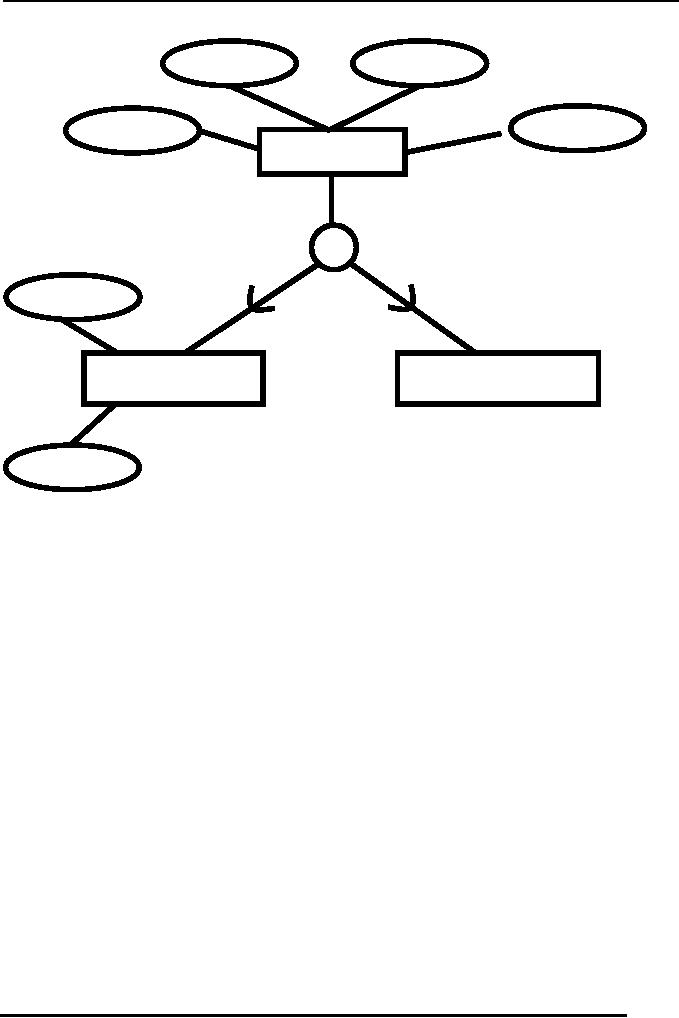
Database
Management System
(CS403)
VU
Veh_Id
Model
Price
Registration
VEHICLE
NoOfDoors
CAR
TRUCK
Pessengers
Fig
2-b
The
Figure2b shows the supertype
and subtype relationship among
different type of
vehicles.
Here we can see that the
Vehicle has only two
subtypes, known as Truck
and
Car, As
it is normal to have a number of
other vehicles in the
company of a certain
type
but
when we have noted just a
limited number of vehicles
then it means that we are
not
interested in
storing information for all
the vehicles as separate
entities. They may be
stored in
the vehicle entity type
itself and distinct vehicle
may be stored in the
subtypes
car and
truck of the Vehicle.
This is a
scenario where we have the
freedom to store several entities and
neglect others,
and it is
called as partial completeness constraint
rule.
After
the discussion of the Total
Completeness and Partial completeness let us
move to
the
next constraint that is
disjointness and check for
its examples.
Again in
the Figure 2-a. we have
the environment where
patient entity type has
two
subtypes
indoor and outdoor patient. To represent
disjointness we place the letter "D"
in
the
circle which is splitting
the super entity type into
two sub entity types.
Suppose that
the
hospital has placed a restriction on
the patient to be either a n
indoor patient or
106
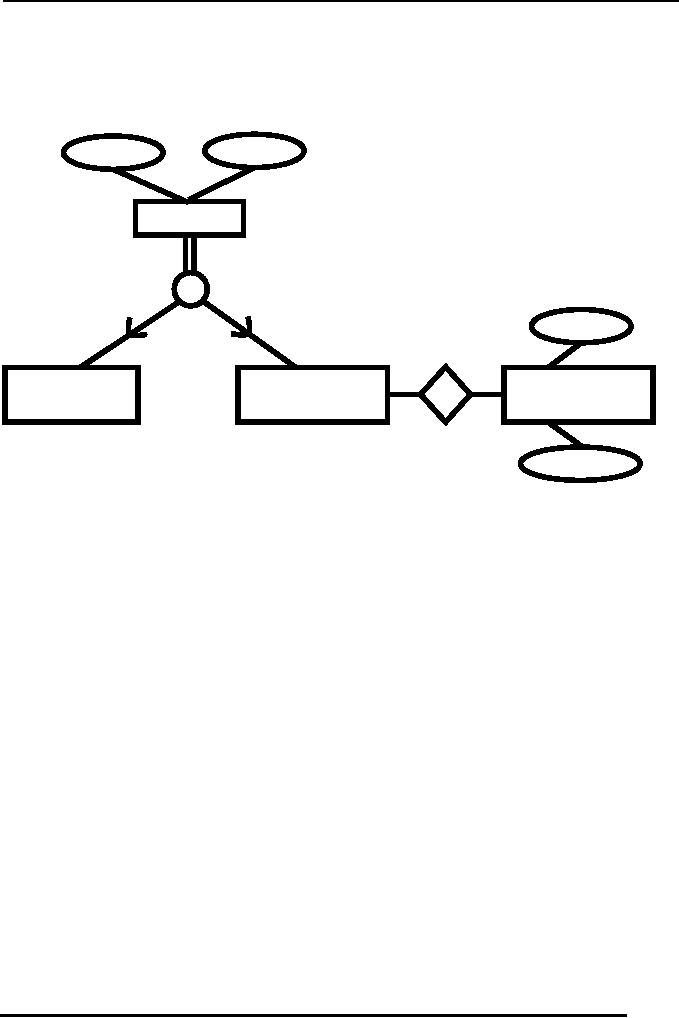
Database
Management System
(CS403)
VU
outdoor
patient, in such a case
there exists disjointness
which specifies that the
patients
data can
not be place in the database in
both the subtype entities.
It will be wither indoor
or
outdoor.
PartName
Part_No
PART
O
Sup_Id
MANUFAC-
PURCHASED
PURCHASED
TURED
Sup_address
Fig-
3
The
figure 3 above shows the
second type of disjoint
constraint which tells that
the entity
subtype
instance can be repeated for
any single entity supertype
instance. We can see
the
relationship
of a certain hardware company
for the parts provided by
the company to its
clients.
Now there may exist an
overlapping situation for a
certain part which is to
be
provided
to a certain firm, but the
manufactured quantity of that
part is not enough to
meet the
specific order, In this
situation the company
purchases the remaining
the
deficient
number of parts form the
other suppliers. We can easily
say that the data
for that
specific
part is to be placed in both the
entity subtypes. Because it
belongs to both the
subtype
entities, this is an overlapping
situation and expresses disjointness
with
overlapping.
Another important thing
which is to be noted here that
the purchased part
subtype
entity has a relationship
with another entity where
the data for the
suppliers is
stored
from whom the parts are
bought. Now this relation
does not have nay
interaction
with
the manufactured parts relation as it is
not connected with its
supertype i.e.--parts
supertype
entity.
107

Database
Management System
(CS403)
VU
Considering
the above discussed we can have
four different types of
combination existing
for
the supertype and subtype
entities.
�
Complete
Disjoint
�
Complete
Overlapping
�
Partial
Disjoint
�
Partial
overlapping
Subtype
Discriminator
This is a
tool or a technique which
provides us a methodology to determine
that to which
subtype
one instance of a supertype
belongs.
To
determine the relation we place an
attribute in the entity
supertype which can
specify
through
its value, that to which
entity subtype it
belongs.
For
example we consider the
example
There can
be two different situations
which specify the placement
or relationship of a
supertype
entity instance in a subtype
entity instance. First
situation is that of
disjoint
situation
where one supertype entity
instance can be placed only in one
subtype of that
supertype.
Let us consider the example
of vehicles above in Figure-2-b it show
that there
can be
two different vehicles car and
truck associated with the
supertype vehicle now
if
we place an
attribute named Vehicle_type in the
supertype we can easily determine
the
type of
the associated subtype by
placing a C for car and a T for
truck instance of the
vehicle.
The
other situation where the
Subtype discriminator is required
the overlapping
constraint;
it is the situation where one
supertype attribute can be placed in more
than one
subtype
entities.
Considering
again the part example shown
in Figure 3, which has an
overlapping
constraint;
In this situation we can have
many solution one common
solution is to place
two
attribute in the supertype one
for manufactured and other one
for purchased. We can
combine
them as a composite attribute,
when we place Y for manufacture and N
for
108

Database
Management System
(CS403)
VU
Purchased
then it means the part is
manufactured by the company, and
similarly the
following
situation will give us further
information
Attribute
Manufacture
Purchased
Result
Y
Y
Manufacture
Purchased
Y
N
Manufactured
N
Y
Purchased.
Significance
of Subtype Discriminator:
Existence
of subtype discriminator helps us a
lot in finding the
corresponding subtype
entities,
although we can find a subtype
entity instance without
having a subtype
discriminator
in the supertype but that
involves lots of efforts and
might consume a huge
time in
worst case
situations.
This
concludes out discussion of
The ER Model in the
course.
109
Table of Contents:
- Introduction to Databases and Traditional File Processing Systems
- Advantages, Cost, Importance, Levels, Users of Database Systems
- Database Architecture: Level, Schema, Model, Conceptual or Logical View:
- Internal or Physical View of Schema, Data Independence, Funct ions of DBMS
- Database Development Process, Tools, Data Flow Diagrams, Types of DFD
- Data Flow Diagram, Data Dictionary, Database Design, Data Model
- Entity-Relationship Data Model, Classification of entity types, Attributes
- Attributes, The Keys
- Relationships:Types of Relationships in databases
- Dependencies, Enhancements in E-R Data Model. Super-type and Subtypes
- Inheritance Is, Super types and Subtypes, Constraints, Completeness Constraint, Disjointness Constraint, Subtype Discriminator
- Steps in the Study of system
- Conceptual, Logical Database Design, Relationships and Cardinalities in between Entities
- Relational Data Model, Mathematical Relations, Database Relations
- Database and Math Relations, Degree of a Relation
- Mapping Relationships, Binary, Unary Relationship, Data Manipulation Languages, Relational Algebra
- The Project Operator
- Types of Joins: Theta Join, Equi–Join, Natural Join, Outer Join, Semi Join
- Functional Dependency, Inference Rules, Normal Forms
- Second, Third Normal Form, Boyce - Codd Normal Form, Higher Normal Forms
- Normalization Summary, Example, Physical Database Design
- Physical Database Design: DESIGNING FIELDS, CODING AND COMPRESSION TECHNIQUES
- Physical Record and De-normalization, Partitioning
- Vertical Partitioning, Replication, MS SQL Server
- Rules of SQL Format, Data Types in SQL Server
- Categories of SQL Commands,
- Alter Table Statement
- Select Statement, Attribute Allias
- Data Manipulation Language
- ORDER BY Clause, Functions in SQL, GROUP BY Clause, HAVING Clause, Cartesian Product
- Inner Join, Outer Join, Semi Join, Self Join, Subquery,
- Application Programs, User Interface, Forms, Tips for User Friendly Interface
- Designing Input Form, Arranging Form, Adding Command Buttons
- Data Storage Concepts, Physical Storage Media, Memory Hierarchy
- File Organizations: Hashing Algorithm, Collision Handling
- Hashing, Hash Functions, Hashed Access Characteristics, Mapping functions, Open addressing
- Index Classification
- Ordered, Dense, Sparse, Multi-Level Indices, Clustered, Non-clustered Indexes
- Views, Data Independence, Security, Vertical and Horizontal Subset of a Table
- Materialized View, Simple Views, Complex View, Dynamic Views
- Updating Multiple Tables, Transaction Management
- Transactions and Schedules, Concurrent Execution, Serializability, Lock-Based Concurrency Control, Deadlocks
- Incremental Log with Deferred, Immediate Updates, Concurrency Control
- Serial Execution, Serializability, Locking, Inconsistent Analysis
- Locking Idea, DeadLock Handling, Deadlock Resolution, Timestamping rules